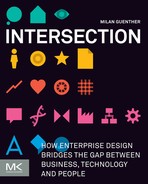10
Design Program

Given the ambiguity and complexity of the design process at the enterprise level, it is clear that integrating design practice into organizational life is no easy task. Assembling a skilled and diverse team, determining a suitable approach, and integrating stakeholders are the right ways to go for individual design projects with a limited scope. In order to address enterprise-wide design challenges however, the problems get too large and unmanageable to be tackled all at once. While the concept of project work is deeply embedded in all design activities, in isolation they fall short of addressing long-term strategic matters.
This chapter is about embedding the practice of design in the enterprise context. Using the twenty aspects of the Enterprise Design framework as a guide, it deals with the strategies, themes, and practical issues of delivering a strategic design program in the enterprise.
Putting design into actual initiatives and organizational structures, integrating various groups and departments, defining themes and philosophies, encoding design into guidelines and frameworks, or simply deciding what to tackle next — the challenges you might be facing are manifold and too diverse to discuss them here at length. Instead, this chapter is a collection of thoughts and hints, based on years of professional experience that gave us an idea of what actually works.
It is not enough to have a talented designer; the management must be inspired too. The creative process is very disorganized; the production process has to be very rational.
Bernard Arnault, LVMH
Strategy
This book talks a lot about strategic design, and we see the Enterprise Design framework as a way to make design as a practice strategically relevant to an organization. Applied in reality, this means connecting design programs and strategic management practice in a way that they assume a joint responsibility to shape or re-shape the enterprise, and to bring a strategy to life.
Bringing together strategy and design results in a symmetrical relationship. From one perspective, a key task of design initiatives is to illustrate how a certain strategic choice might turn out once it is executed. Vice versa, the outcomes of a design process serve the purposes of informing and guiding strategic thinking, illustrating desirable futures. Once defined in concrete scenarios, the choice of which future to pursue becomes much easier.
Seen from a design perspective, the topics of strategy boil down to the question how the organization chooses to appear in the lives of people it addresses and those involved in running the enterprise, and the value it creates for them. A vital prerequisite for such a strategic design is grounding this work in an enterprise- wide view, and connecting design practice as applied to concrete outcomes to the conceptual thinking behind it.
This section is based on a model from Michael Treacy and Fred Wiersema. It describes three generic value disciplines for a company to excel in, while not leaving behind the remaining two. We applied them to envision specific options to pursue, defining both a design strategy and a strategic vision.
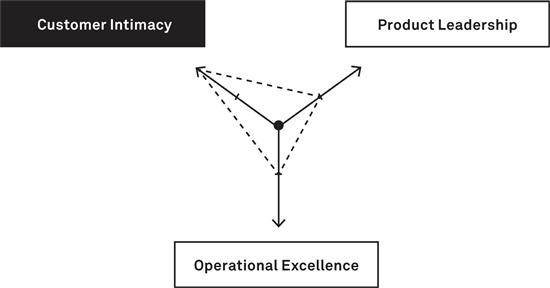
Customer Intimacy
This area of focus involves envisioning a strategy that centers on designing the relationship with individual customers, and what they experience when interacting with the enterprise. As the label suggests, Customer Intimacy strategies are about turning that relationship into a genuine love affair.
There are few brands that can claim to engage customers in such a deep and profound way, but all that do have something in common: a deep understanding of those they are addressing with their products or services, and tailoring their offerings almost to the individual customer. They excel in constantly meeting and exceeding customer expectations, handling interactions on a personal level, and managing a strong brand identity that has a meaningful place in their lives. The role of design is to shape the enterprise in a way that it supports creating this kind of close and trusted relationships.
Design Strategy: Design all parts of the enterprise to delight and surprise customers, and to empower all other actors to deal with individual customer needs and situations
Strategic Vision: Envision what such an intimate relationship can be like in day-to-day practice, and picture meaningful roles for the enterprise to play in people’s lives
The strategy, energy and resources of customer-centered organizations are aimed at processes enhancing knowledge of an engagement with their customers. And prioritizing these over keeping conventional competitive barriers.
peter J. Bogaards (bogieland.com)
EXPERIENCE
designing the enterprise to serve the customer experience, making offerings and services valuable and meaningful to individual clients.![]()
ACTORS
designing for the wider group of actors involved in delivering the customer experience.![]()
PEOPLE
understanding addressees on a personal, empathetic level and learning about their lives.![]()
INTERACTION
designing for customer interactions that reflect personal relationships and individual behaviors.![]()
ORGANIZATION
empowering front-line staff to make informed ad hoc decisions when an individual need arises.![]()
PLACES
making places to bring together customers with other actors, and foster an active exchange.![]()
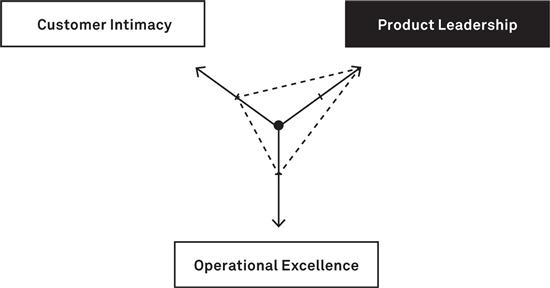
Product leadership
This type of strategy is for organizations focusing on making innovative and disruptive offerings to the market. Achieving excellence through Product Leadership entails a strong focus on market trends and research, to identify, design and implement new products and services in a rather short time frame. The idea behind such an approach is to stimulate the enterprise as the organization, its wider ecosystem and its market environment to deliver the next big thing.
The role of design in such an environment is to bring together the dimensions of creating a strong brand identity and a winning product design, as well as the people, processes, and assets behind their delivery.
The enterprise of a product leader consists of managing a dynamic environment of actors involved in the identification and creation of new opportunities, and leading this dialogue with research probes, ideation, and vision prototyping. For design practice, this translates to opportunistically co-creating the future with those at the forefront of its discovery and definition.
Design Strategy: Focus on continuous inquiry into a dynamic enterprise and market environment, generating ideas and turning them quickly into concept cars
Strategic Vision: Anticipate future offerings both near-term and long-term, and designing the enterprise as a system of services and internal assets to deliver them
IDENTITY
making the brands of the enterprise synonymous with meaningful, cutting-edge products and services leading the market.![]()
ACTORS
engaging an ecosystem of partners, lead users, and customers to generate ideas and deliver on them.![]()
STRUCTURE
mapping the structures of the enterprise, its domains and people’s mental models, to find a suitable niche for future products and services.![]()
COMMUNICATION
designing modes and channels to facilitate open communication, announce new developments, and gather expectations.![]()
TECHNOLOGY
leveraging technical possibilities to create novel products and services.![]()
THINGS
producing artifacts that inherit the trends, ideas, and concepts envisioned and make them accessible.![]()
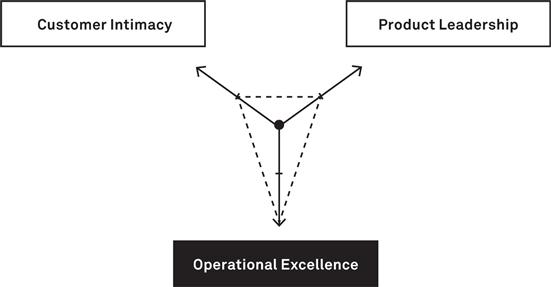
Operational Excellence
This strategic focus area is about optimizing the way the enterprise works, using automation and intelligent operations to minimize efforts and cost, in order to outperform the competition. It means designing the enterprise as though it were a well-oiled machine, striving to provide more value to customers for less cost and effort. Organizations pursuing this type of strategy rely on achieving a good price and high volumes in order to benefit from economies of scale, while maintaining the expected quality and value propositions.
Design for Operational Excellence involves a continuous search for improvements, often refining rather than redesigning the enterprise. It contributes to this strategic focus by designing all kinds of systems that are involved in delivering on that promise. Capabilities to understand actual needs for a large customer base allow us to gain insights into what elements of an offering are considered essential, and what can be removed or downgraded to improve the competitive positioning. This definition in turn informs the design of processes supporting their execution and automation.
Design Strategy: Design the enterprise to support process execution, striving for a smooth flow of communication and work between people, and mindfully automating activities
Strategic Vision: Develop illustrations of systems such as products and tools, procedures and services that support running the enterprise and connect actors to underpin processes and activities.
ARCHITECTURE
making the enterprise a system working in an efficient and lean fashion, supporting the flow by streamlining structures and processes.![]()
TOUCHPOINTS
Orchestrating, connecting, and designing touchpoints to make business processes accessible and directly involve customers and other actors in their execution![]()
FUNCTION
designing functions as capabilities to better run the enterprise, serve customer goals, and make it fulfill a clearly defined purpose.![]()
INTERACTION
designing interactions with automated components and self-services to support all typical transactions and activities as well as exceptions and errors.![]()
OPERATION
defining a well-tuned operating model to support human work and automated tasks and measure performance.![]()
SIGNS
developing systems of signs to guide people navigating the enterprise and support handling a high volume of cases.![]()
Themes
This section describes design themes, topics to be addressed with a design program. Themes usually represent fundamental aspirations of key stakeholders. They guide both the choice of challenges to tackle and the chosen approach. To a design team, well-defined themes often take the form of a few statements or short stories, and provide both a rich source of inspiration and a basis for making conceptual decisions. In the enterprise context, themes for high-level design programs tend to cycle between innovation and consolidation as guiding trends.
Innovation: Limiting the scope of the design program to a well-defined theme, often following an external trend, new technology, or other kind of develop - ment. The design task is to define a way to creatively respond by seizing opportunities as they emerge and laying out a bold vision of the future.
Consolidation: Mapping the existing assets and components of the enterprise to better align them with each other and benefit from global platforms and common resources. This task of “silo-busting” is one of the core competencies of design, bridging different viewpoints by delivering a unified vision.
Themes often depend on global decisions or events such as an acquisition, a re-branding, or simply a new CEO. This section portrays a set of topics which are archetypes for individual themes and narratives for design programs in the enterprise context to start from.
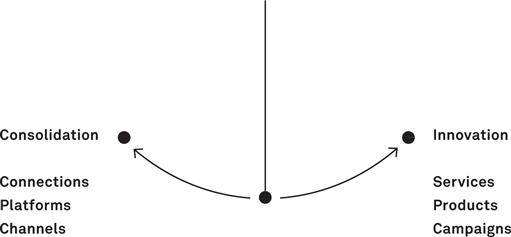
Customer experience
Taking the Customer Experience as the guiding theme defines the objectives of a design program in terms of its impact on customers, and recognizes them as the most important stakeholders of the organization. It means designing the overall shape of the enterprise as it manifests itself in customer interactions, from initial awareness to conversion and sustaining customer relationships.
Connecting a business to the customers it addresses is a typical task for design practice, working in conjunction with Marketing, Product Design, and Customer Service. In today’s organizations, there often seems to be a mismatch in design practice as it is applied to communication, to the offerings themselves and to the services provided at the different stages of the customer journey.
Instead of a coherent whole, customers have to deal with isolated and disjointed parts. Designing for an end-to-end experience is a way to leverage design in order to stand out in the market.
A remarkable Customer Experience can come from many factors, but it is key to define the theme in alignment with at the chosen strategy—any of the three focus areas previously described can provide the leverage to make it happen:
Capture concisely and in a few words what the experience you envision should be like, and the particular benefits it brings to the customer.
Use this vision to guide the re-arrangement of enterprise elements, bringing them together to reshape the customer journey.
EXPERIENCE
![]() how is the desired customer Experience like?
how is the desired customer Experience like?
TOUCHPOINTS
![]() what touchpoints are used to facilitate interactions?
what touchpoints are used to facilitate interactions?
PEOPLE
![]() who are the customers we are designing for?
who are the customers we are designing for?
INTERACTION
![]() how do we interact with customers?
how do we interact with customers?
ORGANIZATION
![]() how to allocate responsibilities to support the customer?
how to allocate responsibilities to support the customer?
PLACES
![]() what places are driving the customer Experience?
what places are driving the customer Experience?
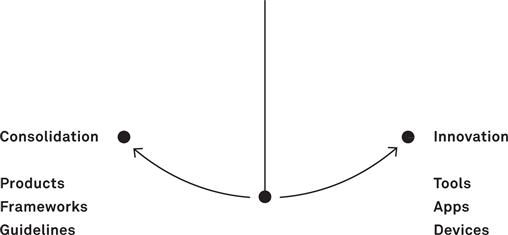
Digital workplace
A key topic to be addressed in the enterprise is how people contribute to its endeavors, as employees, partners, or in other roles. The emerging concept of work technologies and environments, now often labeled the Digital Workplace, is about designing the enterprise in a way that it supports people connecting, collaborating, making decisions, and solving tasks.
The addition of digital is essential, because it is the digitalization of technologies and structures that is transforming the world of work at an astonishing pace. It allows a large part of the working population to be liberated from fixed locations, potentially working with people all over the world. The communication channels, tools, and systems running today’s organizations are at the forefront of an ongoing shift to a more dispersed, flexible, and dynamic economy. In today’s work environments, tools and technologies remain neffective and hard to use, often preventing rather than supporting productivity and exchange.
As a theme for a design program, the objective of reshaping work translates to the creation of an interconnected set of useful tools and social environments:
Capture in a short narrative how you envision connecting people to information, conversations, and business processes that drive the enterprise.
Describe ways to enable both the enterprise and individuals to realize the potential of working digitally
IDENTITY
![]() how to support the brand identity and culture?
how to support the brand identity and culture?
SERVICES
![]() what services are driving the Digital Workplace?
what services are driving the Digital Workplace?
FUNCTION
![]() what purposes does it serve, what processes does it enable?
what purposes does it serve, what processes does it enable?
COMMUNICATION
![]() how does it support collaboration and communication?
how does it support collaboration and communication?
INFORMATION
![]() how does it make information accessible and findable?
how does it make information accessible and findable?
THINGS
![]() what devices are used to access it?
what devices are used to access it?
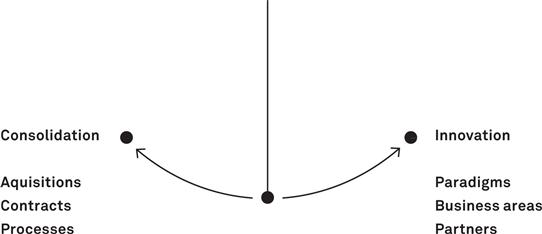
Business platforms
The idea of designing enterprises around Business Platforms out of the emerging business models using the Internet as the main driver of the enterprise. Inspired by companies like Amazon, Apple, or eBay, they attempt to turn themselves into a digitally supported platform driving customer interactions, marketplace collaboration, and internal operations, thereby expanding their business significantly into new domains and segments.
As a theme for strategic design initiatives, creating a business platform for the enterprise is about designing a central system that serves a large number of actors in the enterprise ecosystem at once. It is about supporting continuous business development by integrating new suppliers and partners and expanding the scope of offerings. Platform companies excel at redefining and extending their business, leveraging existing assets to reach new target groups, and gathering data to better serve customers and identify opportunities.
Bring together operational processes and workplace technologies to drive the Customer Experience with e-business offerings, and identify opportunities for collaboration open to the wider marketplace
Determine ways to create flourishing ecosystems around your market offerings, supported by a digital infrastructure of owned and third-party platforms
Capture in a design theme how that ecosystem could be structured, and how the platform to be created could support its development over time
ARCHITECTURE
ACTORS
![]() who accesses your platform?
who accesses your platform?
CONTENT
![]() what is being echanged?
what is being echanged?
BUSINESS
![]() how will the revenue stream work?
how will the revenue stream work?
OPERATIONS
![]() what is needed to operate it?
what is needed to operate it?
TECHNOLOGY
![]() what are its technical components?
what are its technical components?
SIGNS
![]() how to navigate across the platform?
how to navigate across the platform?
Practice
There is a multitude of potential options for integrating design in an organization, considering not only ways to make the practice part of organizational structures and operational processes, but also aspects of working culture and stakeholder engagement. The success of a design program depends on finding the right approach, balancing both the hard and soft factors of creative work in a complex environment. Taking design practice to the enterprise level also requires granting practitioners the space and resources needed to have an impact on the larger ecosystem. Confined to the common silos of Marketing, Product Development, or Corporate Communications, the results it produces are likely to be as limited as the selected scope predicts. But even when seen as a strategic resource for developing the enterprise, design often seems to be at odds with management practice and the mindset of many business people.
This section is about addressing these practical issues of embedding design in daily work with a strategic impact in mind. While this without doubt depends on a variety of factors, in our experience it boils down to the creation of a supportive culture across the organization backed by executives and stakeholders, and assembling great design teams to run the projects. We strongly believe that consciously addressing these factors tremendously improves the chances of the design program being a success.
Culture
Many organizations struggle when implementing strategic design practice in real life and making it part of the way they work, even when it is approached from an enterprise-wide view and with top-level support. A common challenge is figuring out a way that sustains bold ideas coming out of design projects, taking them all the way from discovery to execution.
This applies particularly to larger organizations, where decisions and activities touch many parties. They often face issues of making design part of the whole organization instead of just a single department or team, and moving beyond isolated projects to its application to the big picture. But even in smaller settings, there is often a collective mindset antagonistic to the messy process and the flexible way designers work, which prevents design practice from creating and sustaining the stunning results it is expected to deliver.
Groupthink and consensus, or focusing on decisions or feasibility too early are poisonous to design practice. Ironically, attempts to prevent such developments by planning the steps of the process up-front tend to further stifle innovations. Therefore, a key element in this regard is the working culture — the way teams and their leaders deal with design activities, collaborate across disciplines, and approach problems and ideas. We found three key values to be particularly important when developing a strong design culture, to encourage an attitude of creative discovery in the collective mindset.
Championing: A strong design practice needs charismatic leaders who advocate a relentless quest for the best possible outcome, keeping the process agile and flexible, and who commit to achieving excellence in all key aspects.
Experimentation: We have seen great enterprise-wide and strategically significant results coming out of rather limited initial pilots. A prerequisite is that they act as role models for many follow-up projects that together spark a large- scale change.
Courage: A design culture requires being bold in many ways. It means investing in research that many would see as a waste of time, trusting experts but also bold ideas that strike you with their elegance and simplicity, and allowing people to make mistakes even if this takes the project back to the drawing board.
Management
Embedding a design approach in an organization requires turning it into structures and processes, to make it formally part of the activities being carried out. This applies to different levels of management and work practice, from decisions made on a strategic level down to operational management of design-related resources and assets, as well as managing design professionals and working with external partners.
The idea behind the Enterprise Design framework and strategic design initiatives is to bring together aspects often seen as separate matters. However, putting design practice into departments, defined methods, and governed procedures comes at the risk of losing the very characteristics the business aims to profit from. A particular challenge is to make sure design practice is deeply linked to all key parties and everything going on in the enterprise, but at the same time keep design teams independent and agile.
This also means being quite selective about who to involve, and positioning the design approach alongside other valid paradigms such as quality management and continuous improvement, making them co-exist and contribute to a greater whole.
Many projects fall short of their goals because they have a restricted scope, or aim too closely at today’s reality, which stifles their potential even before work begins. Conversely, too broad or far-reaching goals can make it hard to set a direction, and make design teams involve too many parties, leading to a mass of conflicting interests and opinions. We have seen most success stories use a balanced approach.
Executive support: Create a steering group to prioritize and set themes to be tackled by design initiatives. Strategic design requires strong backing by senior executives, on the CEO level or very close to it. Depending on the selected theme, a particular function or line could take a lead role, but a global and relevant theme often makes it hard to pick one.
Two types of projects: Plan a portfolio of strategic design initiatives (lead projects), involving external expertise, and corresponding to the chosen themes, to lead the transformation process. These projects aim to swiftly produce vision prototypes of potential futures. Translate selected outcomes into larger realization projects to define the details, build components and drive change processes.
Mindful integration: The theme should guide the selection of members of the core teams, external parties and contributors, stakeholders taking part in the steering group, and participants in research and validation.
Governance structures: Bringing visions to life requires a proactive management of design activities, separating global strategy and constraints from individual projects, and using selected themes to make them contribute to a larger vision. A governance team should manage the project portfolio, and create a framework that covers their shared base of global assets and guidelines.
Teams
Designing in the enterprise context requires building teams which are diverse in many ways. They need to bring together people representing a variety of disciplines depending on the theme to be tackled and the environment where a transformation is supposed to happen. Moreover, they need the ability to engage in a dialogue about strategic priorities and scenarios with people from an even greater variety of backgrounds, achieving a shared understanding with executives, technologists, domain experts, and most important, people addressed by their designs.
The best design teams we have experienced combine several traits and characteristics. They keep a high level of motivation and dedication even in times of great ambiguity and uncertainty. They share ideas and thoughts without switching into a mode of compromise or committee-like decision making. Experts lead the work in their respective fields, without losing sight of or interest in what others are doing, constantly making an effort to align different viewpoints.
Most of these characteristics are related to social dynamics and human behavior, elements which are not easy to change or influence. Therefore, organizations have to bring together the right people and provide suitable conditions for design to thrive. In most cases, this means working with external design professionals who can bring in the necessary expertise and guide the approach, and also contribute an external and unbiased view on the themes and challenges to be tackled.
Design leadership: Find people combining design expertise with a strong enterprise vision to lead the projects, identify key aspects, and generate visions of the future enterprise. In addition to experience in creative processes, design leads need two capabilities—getting their team to becreative and excited to contribute to something great, and at the same time being demanding and reluctant to compromise on the overall vision in order to sustain it through to implementation.
Mixed teams: The diversity of teams is vital to achieving the open minds needed to come up with bold ideas. Working with aspects of the Enterprise Design framework enables us to identify disciplines and backgrounds to involve in a project. A good design team mixes generalist and specialist profiles, junior and senior people, as well as team members from different functions or units in your own organization with external professionals.
Building bridges: Use research professionals and design generalists (Hybrid Thinkers) as connectors, bridging lenses applied by members of the design team, and reaching out to the project environment. Such profiles help when developing the understanding needed to inform design work, as well as for engaging with stakeholders to mix in concerns and priorities.
Engagement
The role and strategy of a strategic design program depends largely on the enterprise environment it is embedded in. In business practice, the term enterprise is often equaled with large organizations, and integrating strategic design into a large corporate environment is a key scenario for the Enterprise Design framework. But also in other cases, the multitude of different things to consider makes its twenty aspects highly applicable to guide any design program.
At eda.c, we applied the framework in different cases, with clients of varying size, from diverse industries and following different strategic objectives. Depending on the environment, there are different strategies to engage a client or organization to define and face a design challenge.
Large organizations: this applies to work with large companies and international groups, but also public bodies or non-profit organizations. Guided by the aspects to be considered, the scale of design projects tend to grow quickly, learning about a multitude of interests and parallel projects already in the discovery phase. Therefore, it is important to keep the project in a fluid state for some time, allowing for research and alignment activities and questioning the original briefing. Nevertheless, it is critical to quickly generate and communicate a vision of a potential future, for example, by producing a comic or video to be shared. Instead of attempting to boil the ocean, the initial goal is to create the engagement and visibility needed to go a first step. Even if the proposed initial outcome is rather limited in scope, it helps to align people on a more significant transformation in a later stage.
Small and medium organizations: Compared to large corporations, working with small organizations is somewhat different. While the exposure to the organization and involvement of executives can be achieved much more easily, it often entails achieving significant change within limited time and tight budget restrictions. When applying the Enterprise Design framework to such an environment, it is vital to early select a limited set of aspects considered initially relevant. This enables a rigorous scoping of the early project phases to get from research to vision work in a matter of weeks, guiding subsequent larger implementation-oriented projects.
Startups: Working with (technology) startups is particularly exciting, because it entails both the opportunity and the challenge to invent everything from scratch. The aspects of the Enterprise Design framework are a good guide to selecting the challenges to tackle and defining the overarching design theme. The often chaotic way startups work requires working virtually as part of the startup team of entrepreneurs, technologists, and often also shareholders. The process needs to focus on rapidly co-creating working prototypes, constantly expanding the scope to tackle the next most urgent design challenge.
Framework
Project work embedded in a strategic design program is characterized by the fact that the outcomes of design work are only meaningful as a means to gradually transform the whole enterprise toward a desired target state. In order to be effective, individual initiatives have to effectively contribute to a shared goal. The underlying strategy and design themes are suitable ways of expressing that goal across multiple teams and projects. But the challenge of achieving a coherent design of the enterprise requires us to make its components work together as a system.
In many ways, a strategic design program applied to an enterprise ecosystem is fundamentally different from a single design project. While the scope of such a program is very broad in comparison, it has a much lower level of control on individual outcomes. Instead of designing a finished object, artifact ,or other type of outcome, the goal of a design program has to be a transformation of the enterprise. Yet, any such change has to happen at a small scale of transactions, experiences, and communication flows.
Therefore, an important part of any such program is the elaboration of an overarching framework, put in place to support design work on individual challenges, and holding the different pieces and projects together. The main goal behind a framework is ensuring alignment and fit of outcomes into the enterprise context. Just as the Enterprise Design framework described in Part II, a design framework for a specific enterprise is about a set of aspects that is relevant for design teams to consider, aspects the enterprise strives to address in a coherent and meaningful fashion. Consequently, one of its key roles is that of a list of questions to be addressed in the course of the design process. In practice, a design framework serves several interrelated purposes of design work:
Principles: A list of answers to recurring questions in the form of principles, guiding conceptual decisions, and reflecting values and strategic priorities
Guidelines: A set of guidelines describing the bigger picture, how elements are related, and how to use them within common platforms and infrastructure
Library: A collection of resources, reusable elements, and solutions for common problems, which fit into the greater structure as interconnected modules
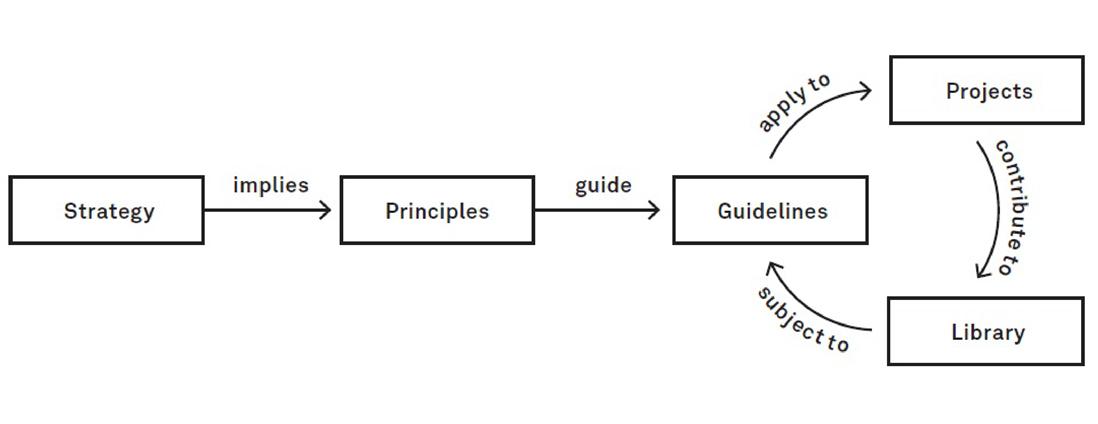
It is therefore essential to treat framework as a genuine design project, choosing adequate ways to describe the elements and convey them to the relevant audiences. The most difficult challenge of a design program in an enterprise environment is not its creation—with a strong underlying strategic vision made visible by lead projects, the direction to go becomes much easier to choose. Making all parts of the enterprise contribute to this idea, and putting it into action step by step can prove to be the harder part. The following elements are the basis for documenting a shared vision into online and offline media, and facilitating the conversations that engage all parts of the enterprise.
Principles
In design practice, principles are high-level statements that guide both design decisions and craft. For strategic design, such principles play a key role. They articulate the shared idea of the enterprise, its identity, values and beliefs. At the same time, they are derived from strategic priorities, experiential goals of key actors, and external conditions. The number of influencing factors is great, and therefore the creation of principles no trivial task.
Unlike principles as found in science or law, design principles do not represent universal truths of nature or binding regulations, but merely expressions of an attitude behind the creative process. They do not contain any direct instructions, requirements, or descriptions.
They should be formulated in a way that is actionable for teams, helping them set priorities and decide on what to address with the outcomes of a design process. But principles should also be generic enough to be applied across different contexts, being the traceable roots for individual requirements or design decisions.
Design is attitude.
Helmut Schmid
A set of well-defined design principles can express the thinking, motivations and mission of the enterprise, thereby giving design work a direction to pursue. Such principles should articulate the enterprise’s strategic choices, design themes, and core ideas.
Guidelines
Anyone already involved in traditional design work is probably quite familiar with the set of guidelines companies use to align the effort. Typically called design manuals or style guides, design guidelines specify global standards, components, and processes that apply to design projects, imposing design constraints and describing shared assets for reuse.
Most classic approaches of standardizing design work fall short of providing such a comprehensive foundation at the enterprise level, which results in projects and their outcomes drifting apart. Brand guidelines describe a set of visual elements, but ignore the behavioral aspects of identity. An architecture blueprint maps the way information systems are connected, but without grounding this in the Customer Experience served by those systems. For a design team, it is hard to develop a comprehensive view of the environment since many questions are not addressed. On the other hand, many practitioners feel quite constrained in their creative work by overly rigid instructions.
We found the best guidelines to adopt a systematic approach, by addressing each concern separately while rooting them in a fundamental set of principles. The Enterprise Design framework provides a good basis to do this, and allows us to develop our fundamental thinking and standards about the various aspects of design work. This includes the way an enterprise appears, communicates, behaves, operates, and structures its business. These guidelines then support our use of the library, the collection of assets to be reused in projects.
Library
In our own work at eda.c, we are asserting a paradigm shift from monolithic solutions and detailed deliverables to flexible systems. Instead of making websites, we are designing for apps, information feeds, and mashups. Instead of documents describing just one design, we are designing templates, standards, and patterns. This development is visible across all domains touched on in Intersection, and means that the focus of design work changes from looking at individual solutions to creating modular structures.
A design library is a catalogue of different types of modular elements to be leveraged, reassembled, and reused in design projects. It contains all elements that are considered part of the design framework, and provides design teams with the rationale, description, and documentation to incorporate them into their work.
Patterns: Documented solutions to recurring design challenges, to be adapted to their context of use
Components: Functional or structural assets ready for direct reuse in a project
Platforms: Assets used as infrastructure elements providing a foundation to base on
Again, the aspects described in the Enterprise Design framework are a good basis for defining the elements to include in a design library according to different concerns of design. The different elements managed here are then used as building blocks to speed up the design and implementation of new and enhanced outcomes, leveraging infrastructure and assets. These in turn add reusable outcomes as new elements of the library.
AT A GLANCE
A strategic design program aims to make an enterprise benefit from design practice, incorporating design into all aspects of its activities and endeavors. This requires alignment with strategic decisions, integrating design work into the organization, and ensuring that everything contributes to one greater vision of the enterprise’s future.
Recommendations
Engage in a dialogue between strategy and design, translating the strategic vision into suitable design strategies, and in turn informing strategic decision making by turning the vision into tangible illustrations
Express the strategic intent behind all design work as a set of a few connected themes, capturing in a short statement how the future enterprise should appear in people’s lives
Integrate design work into the organization, combining a formal organizational and operational model with by leadership, cultural change initiatives, and stakeholder engagement
Elaborate a design framework to align different design initiatives, leverage shared assets and reusable outcomes, and convey the common ground that brings everything together
